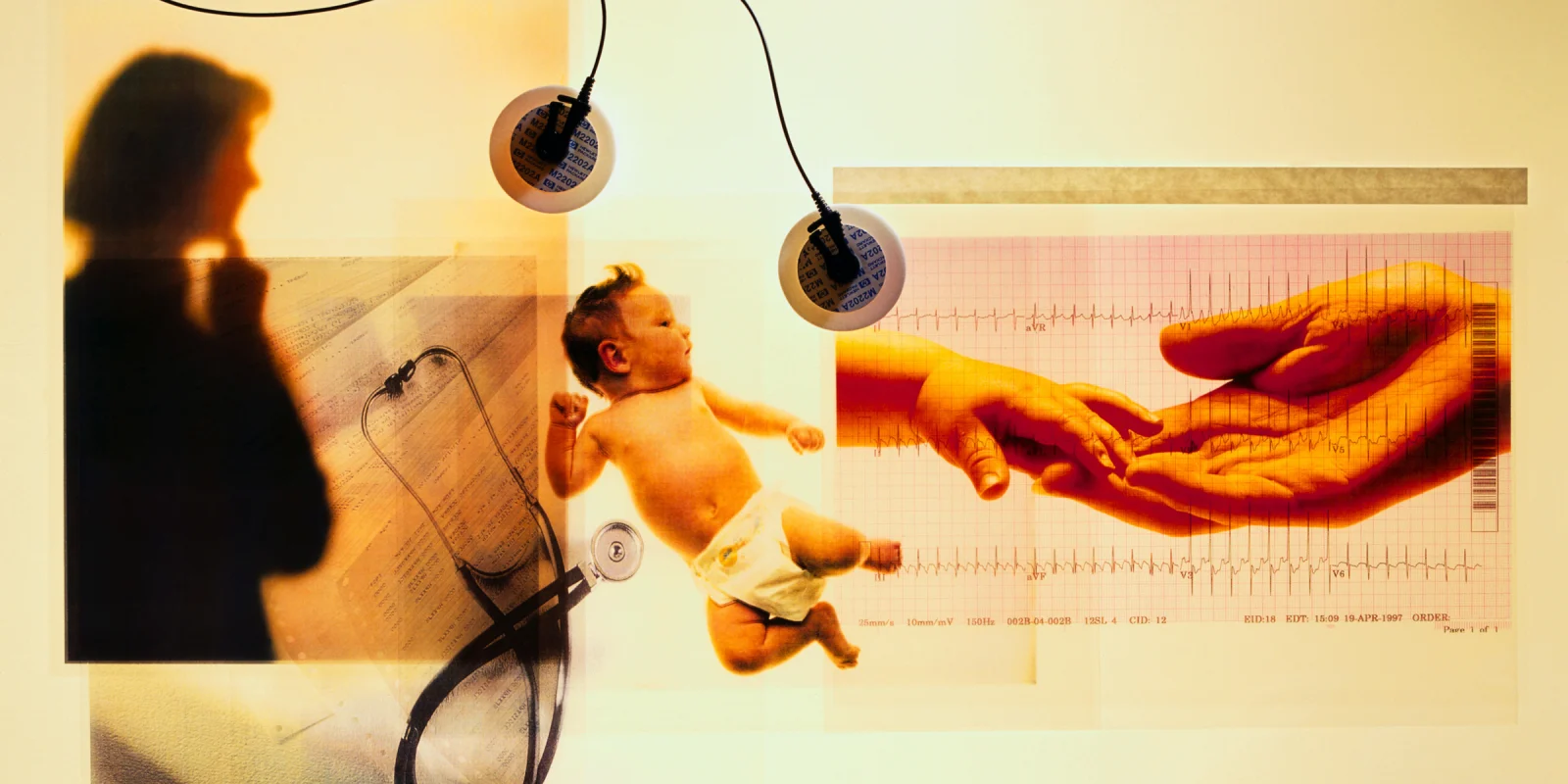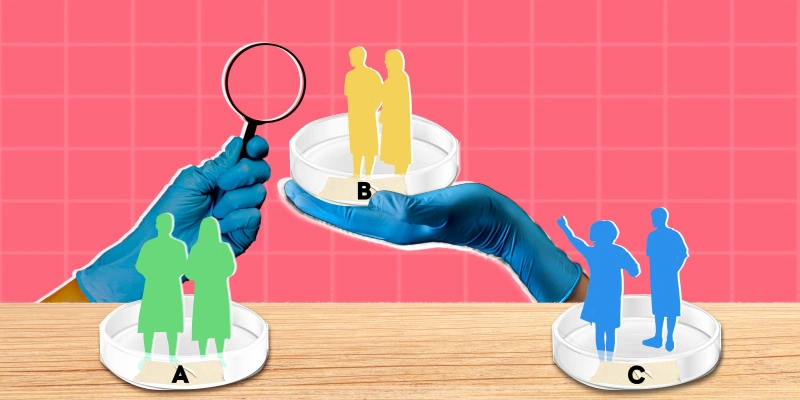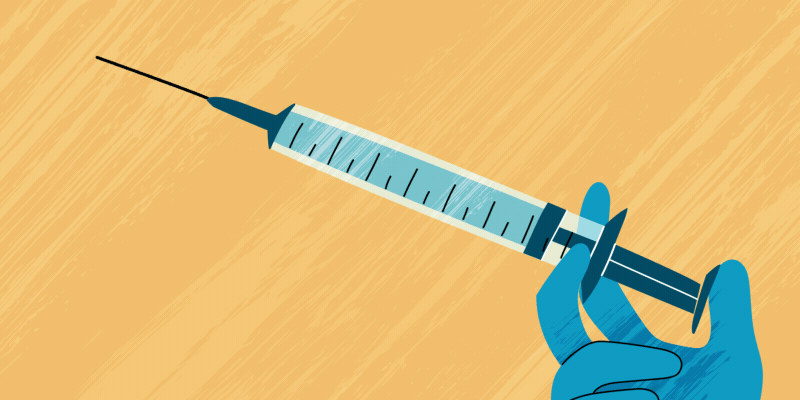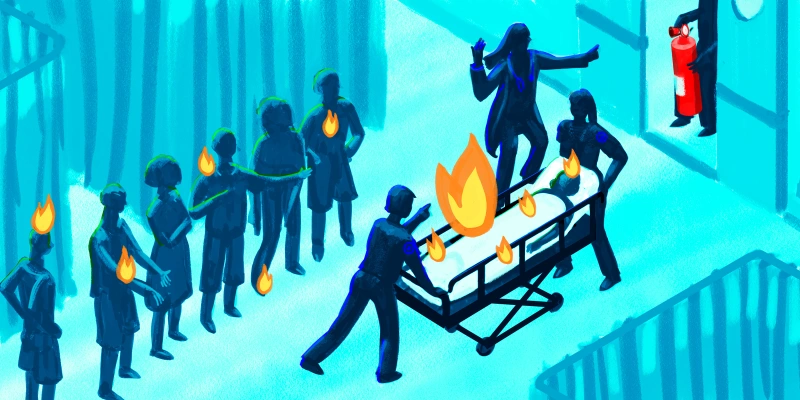In summer 2025, Doximity ran our Women in Medicine essay contest. We are happy to announce this as the runner-up.
I am sitting on a hospital-scrub-blue cot, one of a row of cots in the Taos, New Mexico ER, separated from strangers by thin curtains. In my lap, my two-month-old son, Otis, sleeps. I'm crying. As tears fall, a soft, haunting song drifts through the curtain, its language unknown to me.
"We are on stolen land here," I think, aware of the Taos Pueblo just outside. The man finishes his song: "That's a blessing for a mother and her son. I wish you both the best."
It is Thanksgiving Eve, November 2022, my final month of maternity leave. My husband and I thought we could get away for a few days before I returned to work. Instead, I am here with a baby who has stopped feeding and now coughs until he vomits, oxygen dipping low. I had imagined a quick visit for fluids and reassurance before heading back for pie. Instead, his pudgy feet are bruised from too many failed IV attempts. Nurses murmur about an IO IV. I compulsively check his diapers for the blue stripe that won't appear. We are admitted overnight.
As a med/peds trained primary care physician, I know the script: ex-term two-month-old, newly immunized, admitted with bronchiolitis and dehydration. I also know this critical access rural hospital rarely treats infants this young.
That night, as I pump milk he doesn't take and hold him on my chest instead of laying him in the crib they offer, a nurse asks: "Should we try for another NG bolus?" I freeze. Were they asking the mother, or the doctor? I want so badly to take off my doctor hat and just be his mom. Nevertheless, I frantically do math in my head, racking my brain for the right amount of cc/kg I think might be needed here.
By Thanksgiving morning, a new doctor suggests another IV, blood cultures, and maybe a transfer. "What do you think?" she asks. And there it is again — that impossible question.
There's a particular kind of impostor syndrome that comes with doctoring your own child — the creeping fear that you should know exactly what to do, and the crushing realization that in this moment, you don't.
Every day, I make decisions for my patients: when to transfer, when to push fluids, when to wait. I weigh risk and benefit, live with uncertainty, and call it practice. But when it's your own heart lying in a hospital bed, that calculus is unbearable.
I finally, politely but firmly, request a transfer. RSV was surging; New Mexico had no hospital beds. But one had opened in Colorado Springs. Soon, after a brief stop to pack a change of clothes, we board a fixed-wing air ambulance. I take a video for my older son, who will later relish hearing about Otis' first airplane ride. At the tertiary center, three nurses get an IV on the second try. I finally rest.
Otis is now a thriving, goofy almost-three-year-old. But that week in Taos changed me.
It drove home something I've heard other clinicians say often: We know both too little and too much. Too little to see the whole picture clearly, too much to stop imagining what could go wrong.
Life has offered more chances than I ever wanted to practice that balance: sitting by my father's bed while he lay in a coma, hearing my mother share her new cancer diagnosis, watching my brother bravely navigate recovery from alcohol use disorder. Each time, my doctor hat has been both a comfort and a curse. It lets me catch the subtle hesitation in a nurse's face, the early sign in a lab value, the quiet urgency in a physician's tone. But it also sharpens the ache of uncertainty — because when it's your own, you see everything, but never clearly enough.
It showed me that when someone I love is sick, I rarely want to wear both hats. I am a better doctor because I am a mother, and a daughter, and a sister: I know the fear that saturates a family's bones, I know how fragile and precious our "routine" hospital days really are. But I also know my expertise can cloud my vision when the stakes are that personal. I can advocate fiercely, but I don't always know the best way forward.
Those hours in Taos deepened my respect for the unseen weight behind every decision we make in medicine — when to escalate, when to pause, when to say "enough" or "not yet." They reminded me that so much of our work is a leap of faith, an intersection of evidence, experience, timing, and sometimes, luck.
Every patient we see is someone's beloved. I carry that knowledge differently now: not as an abstract truth, but as a visceral imprint from a cold Thanksgiving morning, a song through a curtain, and a blessing I didn't know I needed.
Diana L. Whitney, MD, is a med/peds primary care physician and assistant professor at the University of Colorado School of Medicine. She provides adult and pediatric primary care at Denver Health and serves as a clinical preceptor and mentor for trainees, with academic interests in refugee/newcomer health, gender-affirming care, clinician wellness, and workplace policy reform.
Image by Don Carstens / Getty






